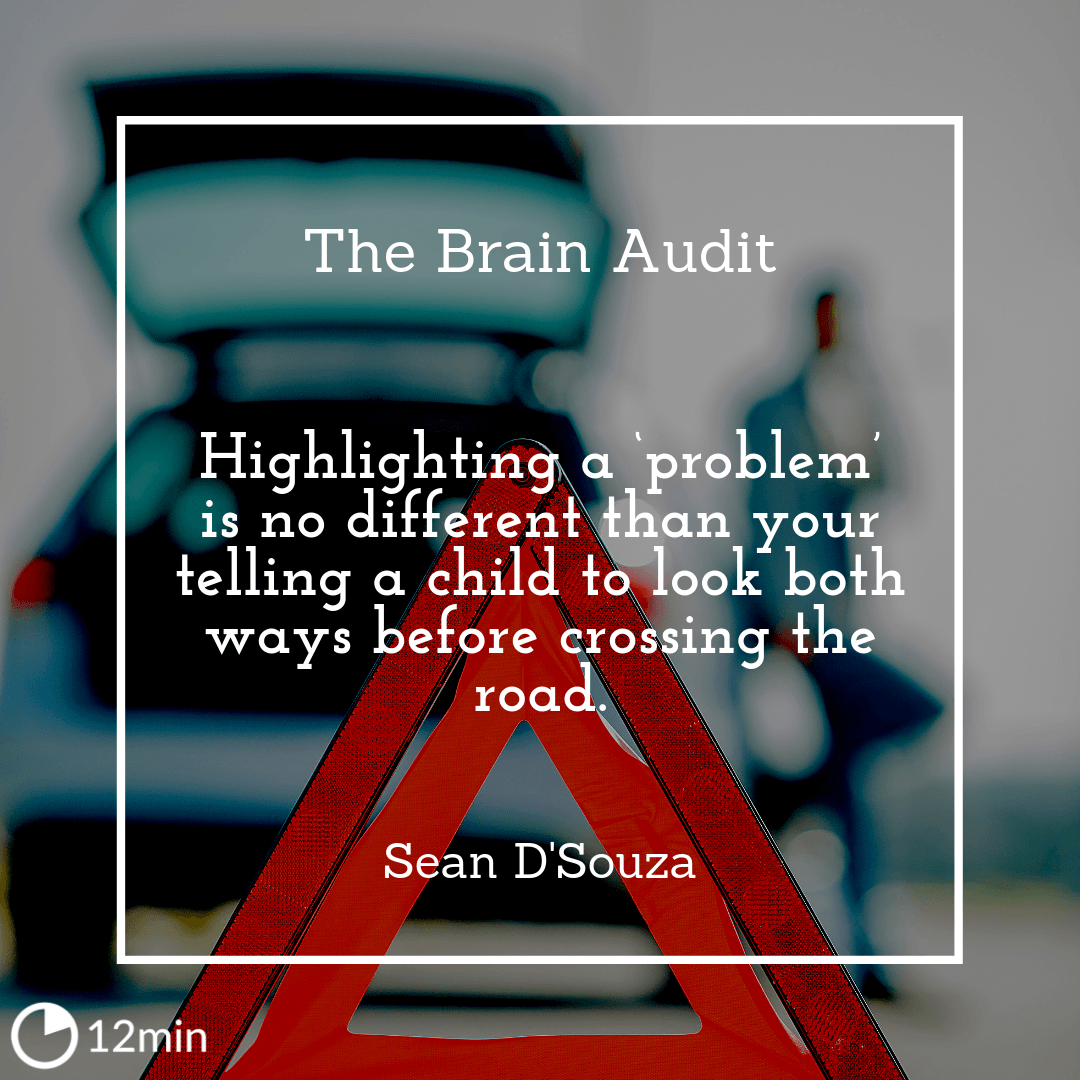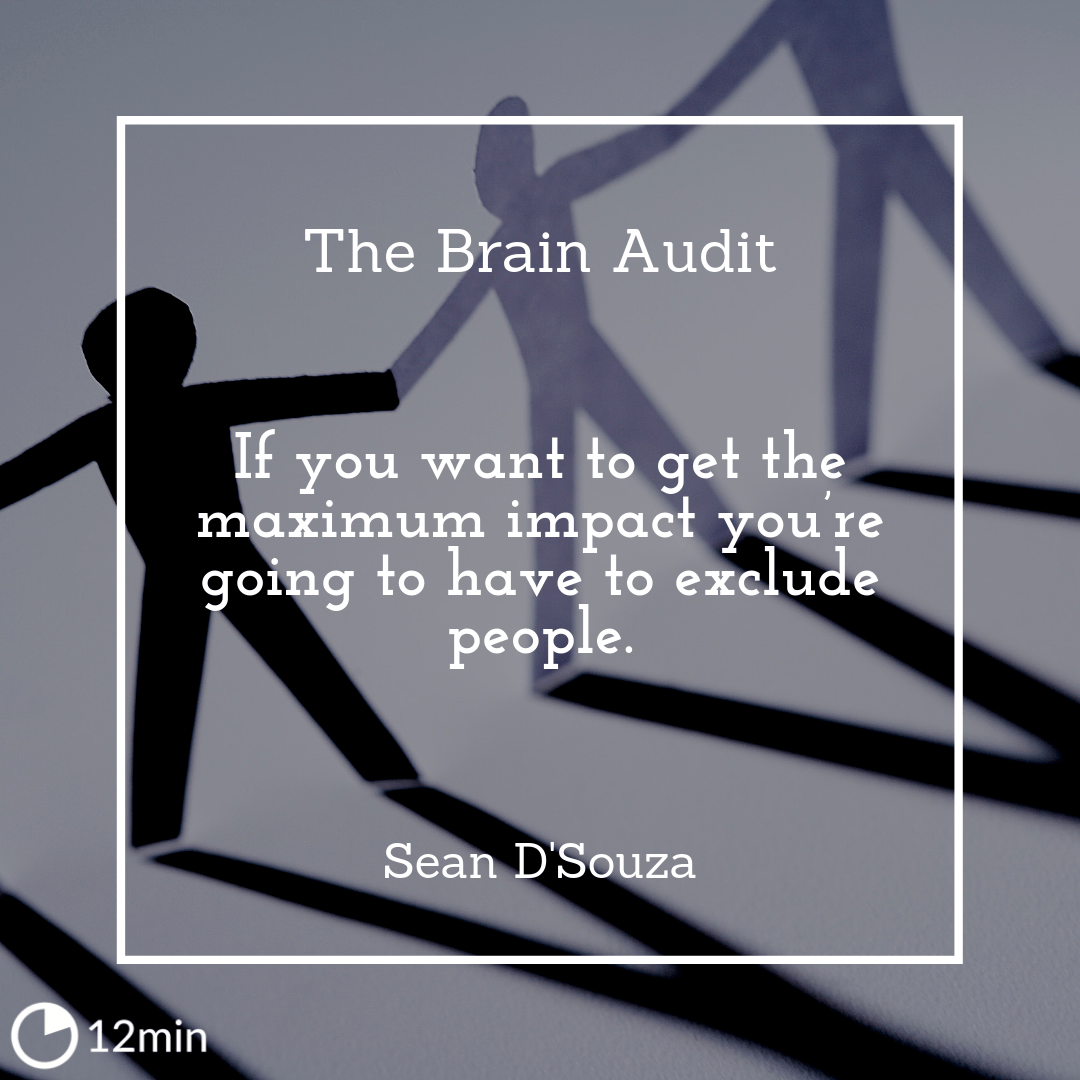The Brain Audit Summary

4 min read ⌚
Why Customers Buy (And Why They Don’t)
In The Brain Audit, Sean D’Souza delves into the mind of the customer to bring us a whole new overview of the sale and why it sometimes falls through.
It’s packed with information on how to attract customers and what they’re looking for in your product, shop, website, or ad.
Sean D’Souza began his journey in marketing after reading Jim Collins’s Good to Great. That book convinced him to switch careers from cartoonist to public speaker, marketing specialist, and author.
BRAINY BUSINESS / THE BRAIN AUDIT
Find out how to attract clients and how to keep them satisfied.
The Brain Audit starts off with a revolutionary idea: “The brain works just like a conveyor belt”. And that conveyor belt is waiting for 7 “bags”, or ideas, in order to complete the sale.
“The Brain Audit PDF Summary”
According to Sean D’Souza, to gain the perfect score in a sale you have to be able to interest your client in your products. At the same time, you have to keep them curious and eager to find out more.
And you can do that by creating a “roller coaster effect”. The seller has to create a sense of security within the client, easily done through well-planned testimonials specifically selected to defuse objections.
Let’s go back a little to the “conveyor belt” and the 7 bags. These “bags” must be followed, developed and respected in this exact order to achieve your expected result. According to The Brain Audit, the 7 bags are:
- The problem
- The solution
- The target profile (the trigger)
- The objections
- The testimonials
- The risk reversal
- The uniqueness
When reading The Brain Audit, you’ll learn how to follow and exploit each bag. You’ll also learn the motivation behind searching the bags in this exact order, from small to big, from problem to complete closure.
In the “Problem chapter,” you’re presented with the idea that our brains calculate every possible outcome of a certain decision in order to keep us alive. That is why “the brain recognizes a problem long before it recognizes the solution to the problem”.

In order to light up the brain, you have to feed it the information it’s trained to notice if it wants to keep you safe.
Here comes the revolutionary idea: despite the fact that most courses and books tell you to highlight the benefits of a product, Sean D’Souza teaches you to underline the PROBLEM, because, after all, benefits are merely solutions.
He provides an excellent example to explain this: a computer problem you didn’t know you had until you’re presented with a solution that fixes it – a slow computer that may present signs of an imminent hard disk crash.
This example can go even further if you think about the fact that we wouldn’t need cell phones if we didn’t know they existed.
D’Souza even analyzes the fact that problems presented first don’t scare the customer because the problem already exists. All you have to do is enhance it in order to highlight a solution to it and future problems that can develop from this initial problem.
Taking this into consideration, we have to isolate a problem if we want to get the message out effectively.
Later in the book, during the “Solution” chapter, you encounter the idea that providing a solution only works if the customer is first presented with a problem. We’re hard-wired to concentrate on the benefits and features, and this will engage your customer.

Our brains respond better to problems simply because this is the natural sequence: first we see the problem, and then the solution. That’s why D’Souza believes “all the solution should do is flip the problem around”, leading to chapter 3 – Target Profile.
Every one of us is different, and we love to believe that we’re unique and special.
When a seller creates a product that targets a certain profile, he includes a lot of people who identify with that specific profile.
The perfect example is that of Anita Roddick, the founder of The Body Shop – a beauty chain that stands out in a market where “beauty products are a dime a dozen” – who found success by appealing to a profile and not a demographic.
Find the problem
A handy tip presented in The Brain Audit is the steps to follow in order to create a profile. They are: start with a demographic; choose a real person from that demographic; speak to that person and find out their list of problems regarding your product or service; pick one problem and expand it; and, last but not least, use a real person for feedback.
After you’ve listened to your target audience feedback, reproduce what you understood from it; in other words – pay close attention to make sure that you’ve understood what you’ve heard.
This book summary will clear the path to a new scientific discovery – you probably receive many messages on a daily basis, but the attention and energy are pointed only to those that matter to you. Follow Sean D’souza tips and make your life easier.
And with this in mind, D’Souza glides into the next chapter – The Trigger. The message that grabs our attention, the one that gives us no option but to respond predictably.
Faced with the problem, solution, and target together, you’re likely to get the trigger if you use the information correctly.
Is there an ultimate solution?
12min’s book summary indicates that any message starts with the problem. The problem gets the customer’s attention. Then the solution kicks in – The Brain Audit.
To keep the client’s attention, you have to bring up more detailed information about the problem. That gets the customer’s attention all over again.
We seem to have about 6 or 7 main objections for pretty much every decision we make – creating a “bag”. When this bag appears, the Objection bag, the customer is more likely to purchase your product regardless of any obstacle.
As D’Souza says in a footnote, during his presentations he only explains the first 3 bags but is always asked for the entire list. So far we’ve reached bag number 4, objections – the first 3 being a problem, solution, and target and the adjoining trigger.
The final 3 bags play an equally relevant part in The Brain Audit: testimonials, risk reversal, and uniqueness.
Like this summary? We’d Like to invite you to download our free 12 min app, for more amazing summaries and audiobooks.








